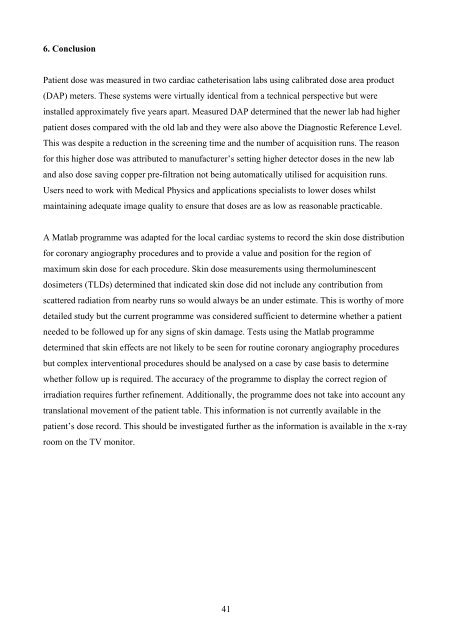Sandra Hopkins Final Report.pdf - University of Surrey
Sandra Hopkins Final Report.pdf - University of Surrey
Sandra Hopkins Final Report.pdf - University of Surrey
Create successful ePaper yourself
Turn your PDF publications into a flip-book with our unique Google optimized e-Paper software.
6. ConclusionPatient dose was measured in two cardiac catheterisation labs using calibrated dose area product(DAP) meters. These systems were virtually identical from a technical perspective but wereinstalled approximately five years apart. Measured DAP determined that the newer lab had higherpatient doses compared with the old lab and they were also above the Diagnostic Reference Level.This was despite a reduction in the screening time and the number <strong>of</strong> acquisition runs. The reasonfor this higher dose was attributed to manufacturer’s setting higher detector doses in the new laband also dose saving copper pre-filtration not being automatically utilised for acquisition runs.Users need to work with Medical Physics and applications specialists to lower doses whilstmaintaining adequate image quality to ensure that doses are as low as reasonable practicable.A Matlab programme was adapted for the local cardiac systems to record the skin dose distributionfor coronary angiography procedures and to provide a value and position for the region <strong>of</strong>maximum skin dose for each procedure. Skin dose measurements using thermoluminescentdosimeters (TLDs) determined that indicated skin dose did not include any contribution fromscattered radiation from nearby runs so would always be an under estimate. This is worthy <strong>of</strong> moredetailed study but the current programme was considered sufficient to determine whether a patientneeded to be followed up for any signs <strong>of</strong> skin damage. Tests using the Matlab programmedetermined that skin effects are not likely to be seen for routine coronary angiography proceduresbut complex interventional procedures should be analysed on a case by case basis to determinewhether follow up is required. The accuracy <strong>of</strong> the programme to display the correct region <strong>of</strong>irradiation requires further refinement. Additionally, the programme does not take into account anytranslational movement <strong>of</strong> the patient table. This information is not currently available in thepatient’s dose record. This should be investigated further as the information is available in the x-rayroom on the TV monitor.41
















